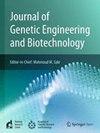Genome-wide association study −Driven drug repositioning for the treatment of insomnia
IF 2.8
Q3 Biochemistry, Genetics and Molecular Biology
Journal of Genetic Engineering and Biotechnology
Pub Date : 2025-05-12
DOI:10.1016/j.jgeb.2025.100502
引用次数: 0
Abstract
Insomnia is a prevalent sleep disorder characterized by difficulty initiating or maintaining sleep, leading to severe health complications, increased mortality, and substantial socioeconomic burdens. Despite therapeutic advancements, effective pharmacological interventions remain limited, necessitating alternative approaches for drug discovery. This study aimed to identify potential therapeutic targets for insomnia by integrating gene network analysis, genomic data, and bioinformatics-driven drug repurposing strategies, aligning with the United Nations’ Sustainable Development Goal (SDG) 3: Good Health and Well-being. Insomnia-associated Single Nucleotide Polymorphisms (SNPs) were retrieved from the GWAS catalog, yielding 3,952 loci. Insomnia risk genes were identified by linking these loci to proximal SNPs (r2 ≥ 0.8) in Asian populations using HaploReg v4.2, resulting in 1,765 candidate genes. A bioinformatics pipeline incorporating ten functional annotations and drug-gene interaction was employed to prioritize gene targets and identify novel repurposed drugs with potential biological relevance to insomnia. Drug-Gene Interaction Database (DGIdb) analysis identified seven druggable targets among 27 biologically significant insomnia risk genes, corresponding to 12 existing drugs. Notably, NRXN1 emerged as a highly promising target due to its strong functional annotation score and its known interaction with Duloxetine hydrochloride and nicotine polacrilex. This study underscores the potential of bioinformatics-driven gene network analysis in identifying drug repurposing candidates for insomnia. Further experimental validation is warranted to elucidate the therapeutic mechanisms of NRXN1 modulation in insomnia treatment.

全基因组关联研究:失眠治疗药物重新定位
失眠是一种普遍的睡眠障碍,其特征是难以开始或维持睡眠,导致严重的健康并发症,死亡率增加,并造成严重的社会经济负担。尽管治疗取得了进步,但有效的药理学干预仍然有限,因此需要替代药物发现方法。本研究旨在通过整合基因网络分析、基因组数据和生物信息学驱动的药物再利用策略,确定失眠的潜在治疗靶点,并与联合国可持续发展目标(SDG) 3:良好的健康和福祉保持一致。从GWAS目录中检索到与失眠相关的单核苷酸多态性(snp),共产生3,952个位点。利用HaploReg v4.2将这些位点与亚洲人群近端snp (r2≥0.8)联系起来,确定失眠风险基因,得到1765个候选基因。采用包含十个功能注释和药物-基因相互作用的生物信息学管道来确定基因靶点的优先级,并确定与失眠具有潜在生物学相关性的新型重新用途药物。药物-基因相互作用数据库(DGIdb)分析在27个具有生物学意义的失眠风险基因中确定了7个可药物靶点,对应于12种现有药物。值得注意的是,NRXN1由于其强大的功能注释评分和已知的与盐酸度洛西汀和尼古丁polacrilex的相互作用而成为一个非常有希望的靶点。这项研究强调了生物信息学驱动的基因网络分析在确定失眠药物再利用候选药物方面的潜力。NRXN1在失眠治疗中的作用机制有待进一步的实验验证。
本文章由计算机程序翻译,如有差异,请以英文原文为准。
求助全文
约1分钟内获得全文
求助全文
来源期刊

Journal of Genetic Engineering and Biotechnology
Biochemistry, Genetics and Molecular Biology-Biotechnology
CiteScore
5.70
自引率
5.70%
发文量
159
审稿时长
16 weeks
期刊介绍:
Journal of genetic engineering and biotechnology is devoted to rapid publication of full-length research papers that leads to significant contribution in advancing knowledge in genetic engineering and biotechnology and provide novel perspectives in this research area. JGEB includes all major themes related to genetic engineering and recombinant DNA. The area of interest of JGEB includes but not restricted to: •Plant genetics •Animal genetics •Bacterial enzymes •Agricultural Biotechnology, •Biochemistry, •Biophysics, •Bioinformatics, •Environmental Biotechnology, •Industrial Biotechnology, •Microbial biotechnology, •Medical Biotechnology, •Bioenergy, Biosafety, •Biosecurity, •Bioethics, •GMOS, •Genomic, •Proteomic JGEB accepts
 求助内容:
求助内容: 应助结果提醒方式:
应助结果提醒方式:


